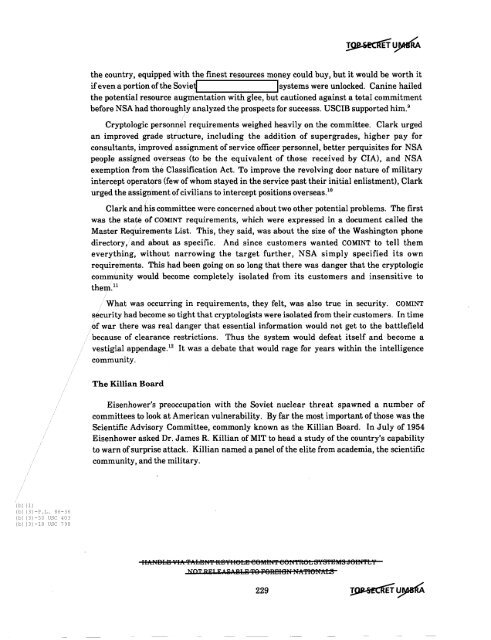American Cryptology during the Cold War - The Black Vault
American Cryptology during the Cold War - The Black Vault
American Cryptology during the Cold War - The Black Vault
Create successful ePaper yourself
Turn your PDF publications into a flip-book with our unique Google optimized e-Paper software.
<strong>the</strong> country, equipped with <strong>the</strong> finest resources money could buy, but it would be worth it<br />
ifeven a portion of<strong>the</strong> Sovie~<br />
Isystems were unlocked. Canine hailed<br />
<strong>the</strong> potential resource augmentation with glee, but cautioned against a total commitment<br />
before NSA had thoroughly analyzed <strong>the</strong> prospects for successs. USCIB supported him. 9<br />
Cryptologic personnel requirements weighed heavily on <strong>the</strong> committee. Clark urged<br />
an improved grade structure, including <strong>the</strong> addition of supergrades, higher pay for<br />
consultants, improved assignment ofservice officer personnel, better perquisites for NSA<br />
people assigned overseas (to be <strong>the</strong> equivalent of those received by CIA), and NSA<br />
exemption from <strong>the</strong> Classification Act. To improve <strong>the</strong> revolving door nature of military<br />
intercept operators (few ofwhom stayed in <strong>the</strong> service past <strong>the</strong>ir initial enlistment), Clark<br />
urged <strong>the</strong> assignment ofcivilians to intercept positions overseas. 10<br />
Clark andhis committee were concerned about two o<strong>the</strong>r potential problems. <strong>The</strong> first<br />
was <strong>the</strong> state of COMINT requirements, which were expressed in a document called <strong>the</strong><br />
Master Requirements List. This, <strong>the</strong>y said, was about <strong>the</strong> size of <strong>the</strong> Washington phone<br />
directory,/and about as specific. And since customers wanted COMINT to tell <strong>the</strong>m<br />
everything, without narrowing <strong>the</strong> target fur<strong>the</strong>r, NSA simply specified its own<br />
requirements. This had been going on so long that <strong>the</strong>re was danger that <strong>the</strong> cryptologic<br />
community would become completely isolated from its customers and insensitive to<br />
<strong>the</strong>m.11<br />
What was occurring in requirements, <strong>the</strong>y felt, was also true in security. COMINT<br />
security had become so tight that cryptologists were isolated from <strong>the</strong>ir customers. In time<br />
of war <strong>the</strong>re was real danger that essential information would not get to <strong>the</strong> battlefield<br />
because of clearance restrictions. Thus <strong>the</strong> system would defeat itself and become a<br />
vestigial appendage. 12 It was a debate that would rage for years within <strong>the</strong> intelligence<br />
community.<br />
<strong>The</strong> Killian Board<br />
Eisenhower's preoccupation with <strong>the</strong> Soviet nuclear threat spawned a number of<br />
committees to look at <strong>American</strong> vulnerability. By far <strong>the</strong> most important of those was <strong>the</strong><br />
Scientific Advisory Committee, commonly known as <strong>the</strong> Killian Board. In July of 1954<br />
Eisenhower asked Dr. James R. Killian of MIT to head a study of <strong>the</strong> country's capability<br />
to warn ofsurprise attack. Killian named a panel of <strong>the</strong> elite from academia, <strong>the</strong> scientific<br />
community, and <strong>the</strong> military.<br />
Ib) (1)<br />
Ib) (3) -P.L. 86-36<br />
Ib) (3) -50 USC 403<br />
Ib) (3) -18 USC 798<br />
IffdiBbEl YIlt 'i'/rbBU'f RBYIf6LB e6MIN'f e6N'fft6L S"iS'fBTtfS 461N'fLY<br />
NOT REI E A ~ A AU '1'9 F8RBI8N ItA:'fI6I(*LS<br />
229
















